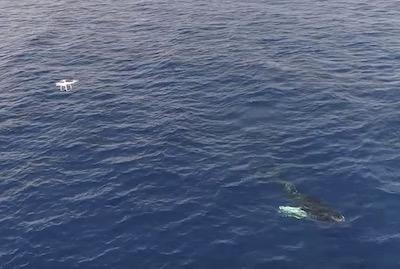Mon, Jun 04, 2018
NOAA, Oceans Unmanned And DJI Team Up For Rescue Efforts
Every fall, pods of enormous humpback whales make their way towards Hawaii, where they can ride out the winter in warm waters of NOAA's Hawaiian Islands Humpback Whale National Marine Sanctuary. For centuries humans have watched this noble migration with awe and wonder. But today, an ever-growing number of these amazing animals are finding themselves in grave danger, entrapped in fishing gear and other marine debris.

Specialists from the National Oceanic and Atmospheric Administration (NOAA) have worked with local volunteers to help save the whales by launching small boats with trained teams to disentangle them while in the water. It’s risky work, bringing people into close contact with the gigantic mammals. Knives on long poles work to cut free ropes that have sunk deep into the whales flesh. Last year, a volunteer was killed when a whale struck him.
To help make the process safer, the whale rescue squads are turning to a new technology: drones.
Matt Pickett, a former NOAA sanctuary manager, is now the founder of Oceans Unmanned, a non-profit organization that facilitates the use of drone technology for marine conservation. Oceans Unmanned recently unveiled the freeFLY program, a new initiative designed to provide aerial support using small drones for large whale entanglement response efforts.
“In the past, we had to get close to the whales at least three times,” explains Pickett. “Once to figure out where the animal was entangled, once to cut them free, and once to make sure the job was done right and nothing was left behind.”
With drones, the team can cut that down to just one step. Using small, remote controlled quadcopters with powerful cameras they can do their initial assessment and final check. "It makes the entire process much safer for both the humans and the whales."
(Source: DJI news release. Image from provided video. Imagery of whales taken by UAS platforms and those depicting rescue activities were conducted pursuant to and under the oversight of NOAA Fisheries’ Marine Mammal Health and Stranding Response Program (Permit Numbers 932-1905 and 18786.) Permits were issued under the authority of the Marine Mammal Protection Act and the Endangered Species Act)
More News
Ground Stop (GS) The GS is a process that requires aircraft that meet a specific criteria to remain on the ground. The criteria may be airport specific, airspace specific, or equip>[...]
Aero Linx: Australian Transport Safety Bureau (ATSB) The Australian Transport Safety Bureau (ATSB) improves safety and public confidence in aviation, marine and rail transport thro>[...]
“The Palo Alto stopover confirmed—yet again—that flight schools and aero-clubs are no longer just curious about electric training; they are ready to buy. In just >[...]
Pilot’s Failure To Maintain Clearance From The Water While Flying At A Low Altitude Analysis: The flight of two airplanes was in cruise flight on a north heading about 50 ft >[...]
Also: 48th Annual Air Race Classic, Hot Air Balloon Fire, FAA v Banning 100LL, Complete Remote Pilot The news Piper PA-18 Super Cub owners have been waiting for has finally arrived>[...]
 ANN's Daily Aero-Term (06.30.25): Ground Stop (GS)
ANN's Daily Aero-Term (06.30.25): Ground Stop (GS) ANN's Daily Aero-Linx (06.30.25)
ANN's Daily Aero-Linx (06.30.25) Aero-News: Quote of the Day (06.30.25)
Aero-News: Quote of the Day (06.30.25) NTSB Final Report: ICON A5
NTSB Final Report: ICON A5 Airborne Affordable Flyers 06.26.25: PA18 Upgrades, Delta Force, Rhinebeck
Airborne Affordable Flyers 06.26.25: PA18 Upgrades, Delta Force, Rhinebeck



